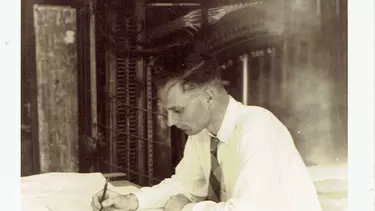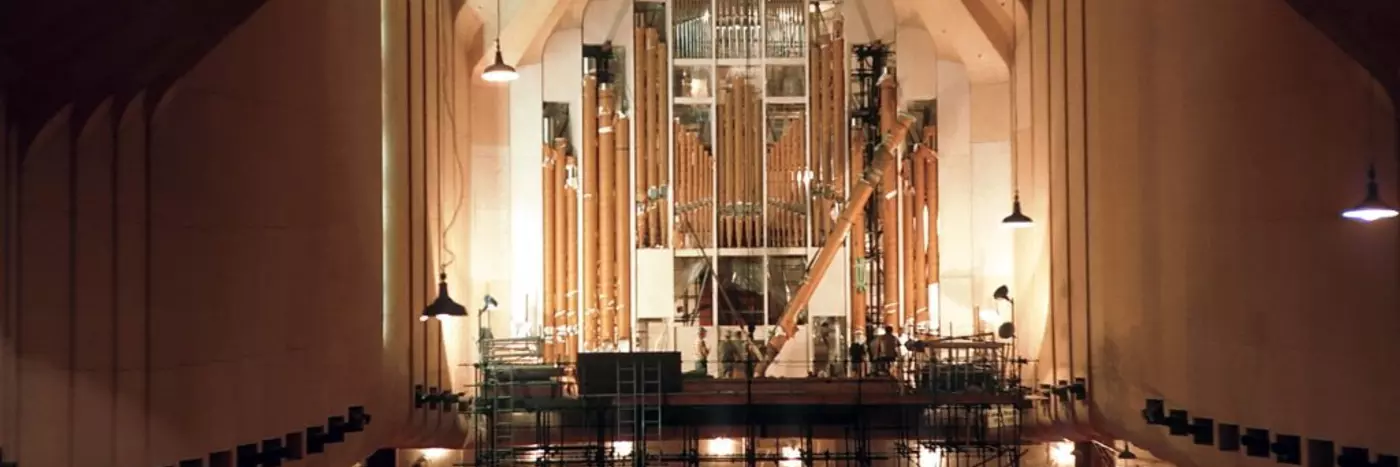Preserving the Grand Organ
Each of the 10,244 pipes will be cleaned by hand – it’s a tricky job

Note - July 29, 2021
The Sydney Opera House is saddened to hear of the passing of Ronald Sharp, designer and builder of the Concert Hall's Grand Organ. Ron worked painstakingly for 10 years constructing the organ, which he also maintained until the early 1990s. The self-taught organ maker was responsible for 20 other iconic organs across the country. His legacy is everlasting. Our thoughts are with Ron's family.
Grammy-nominated organ virtuoso Cameron Carpenter brings a glamour and showmanship to his live performances that would not be out of place in contemporary music. It’s something that isn’t often seen in the classical world – and is sometimes frowned upon – but is a good fit for the Sydney Opera House’s Grand Organ, which is a showstopper in its own right.
Designed and built by Sydneysider Ron Sharp, it took over 10 years to complete at a cost of $1.2m. It is 15 metres high, weighs 37.5 tonnes and has more than 10,000 pipes. Its sense of opulence and majesty makes it a commanding presence in the Concert Hall, the Opera House’s largest and most important internal venue.
At Carpenter’s solo debut at the Opera House in 2012, he took to the stage in fitted, black, spangled skinny pants and a blonde mohawk. Video screens showed his hands gliding over the keys and his feet, clad in boots with rhinestone-studded heels, dancing across the pedals.
Along with Carpenter and other classical exponents including David Drury and Joseph Nolan, both of whom have played with the Sydney Symphony Orchestra, Heather Shannon from the Jezabels composed a piece specifically for the organ for the group’s 2014 concert.
But now the Grand Organ stands silent, surrounded by the cacophony of construction. The Concert Hall is undergoing the first major refurbishment in the Opera House’s history to improve the audience and performer experience. However, the Grand Organ will remain untouched.
The organ is built into the Hall’s southern wall and it was vital that it be protected from dust and sediment from the building works, and temperature and humidity fluctuations that could damage its timber components.
Murray Allan, an organ tuner and restorer who has worked with the Opera House since 2017 says that during construction, “you’ve really got to cover as much as you can, because once the dirt gets into the pipes it causes a lot of problems”.
But as the largest known mechanical action pipe organ in the world, there was really no precedent for what was needed.
Greg Nixon, who works in maintenance at the Opera House and looks after “the air in and around the organ” was asked to find a way to protect the organ.
“We got two layers of sail cloth to cover the pipes, then we diverted the air handling unit that supplies the Concert Hall itself into the organ loft and pressurised it to keep the dust out,” he says.
There was a slight hitch when not enough sail cloth could be found in the country and more had to be ordered from the States – a couple of hundred metres was needed to cover it, one on the outside and one inside.
“To keep the humidity stable we put a couple of circulating fans in that have filters to try and capture any dust that does get in,” he continues.
To protect the timber, they added “a couple of humidifiers to keep it happy”.
The result is a massive shroud sealing the organ until it is ready to awaken.
“Someone goes up once a month [to the organ loft] and has a look to make sure everything’s OK,” Nixon says.
He makes this massive undertaking sound relatively simple. When asked what will be needed to prepare it for performance when renewal is complete, he says: “Nothing! We’ll have to get inside to give it a little bit of a wipe down. Turn the power back on, and play the organ. I hope.”
However Allan says reopening preparations will begin six months before the Concert Hall is due to reopen.
“We’ve got to clean every single pipe, we’ve got to clean all of the soundboards, the console where the keyboards are ... We’ve literally got to clean every single part – as much as humanly possible.”
Each of the 10,244 pipes, which range in size from 9.7 metres to 5mm, will be taken out and individually cleaned using a vacuum, compressed air, pipe cleaners – or yes, wiped down – and it’s all done on location. It’s a tricky job.
“It’s difficult because there’s not a lot of space to work in and they’re very fragile so we have to take a lot of care,” he says.
Grand Organ facts
- The Concert Hall interiors were designed by Australian architect Peter Hall, following Jørn Utzon’s departure.
- Hall was strongly influenced by Utzon’s original concept. With the proscenium removed from the brief, Hall modified the radiating plywood ribs and introduced a circular ‘crown’ above the stage. The ribs fan out from this ‘crown’ to include the organ above the choir stalls.
- The organ was designed and built by Ronald Sharp of Sydney and completed in 1979. It was partially constructed in a small factory in the Sydney suburb of Mortdale.
- It is believed to be the largest mechanical action organ in the world at 15 metres high, 13 metres wide and eight metres deep.
- It has 10,244 pipes, 201 pipe ranks, 131 speaking stops, five manuals and a pedal drawstop console.
- It was budgeted to cost $A400,000. By the time it was handed over to the Opera House, the cost had escalated to $A1.2 million.
- The first of an inaugural series of recitals featuring the organ was given by Melbourne organist Douglas Lawrence on 7 June 1979.
Once it has been cleaned, it will be ready for Allan to tune. A regular tune up, when the organ has been regularly played and maintained, takes two or three eight-hour nights (the Concert Hall is usually too busy to be tuned at any other time). But after this extended period of slumber, Allan expects the tuning to take two to three weeks. It’s a two-person effort, with one on the console and the other inside, making sure volume, tone and speech – the “voice” of the pipe, which can be particularly affected by dust – are correct.
Allan has been told the organ may be required for opening night. “No pressure!” he says with a laugh.
While construction continues during the COVID-19 pandemic, Carpenter notes, the organ is an “inherently socially distant” instrument: it was designed to replace whole orchestras, and the organist is isolated high above their audience.
“It’s easier to enjoy when it’s not coupled with other forces,” Carpenter says. “It’s not that there aren’t great things done for organ and orchestra – that’s all true – but the reality is that [it is designed] to stand alone. That is why it has such great range … It doesn’t require other instruments as today’s stringed instruments do.”
He adds: “I’ve always thought of the organ as outside classical music. It’s one of the reasons that the organ – in its bizarre, broken way – will survive the transitions that we’re going through now with COVID-19 as little else will because it is an independent body; it exists in the digital and physical realm.”
Carpenter has described his relationship to the instrument as “quite troubled” and “obsessive”.
“How do you take this machine that is tied to the wall and has no remote history to you, your life, and is supposed to be an artistic medium and try to get it to do something? It’s almost impossible.
“It gives more but it asks more,” he says. “A lot of the time I am frustrated with it but it can give me something that nothing else can.”
Gabriel Wilder is a Sydney-based journalist and news producer. She has written for The Guardian Australia, Sydney Morning Herald, The Lowy Institute and the University of Sydney.
Twitter @gabrielwilder
